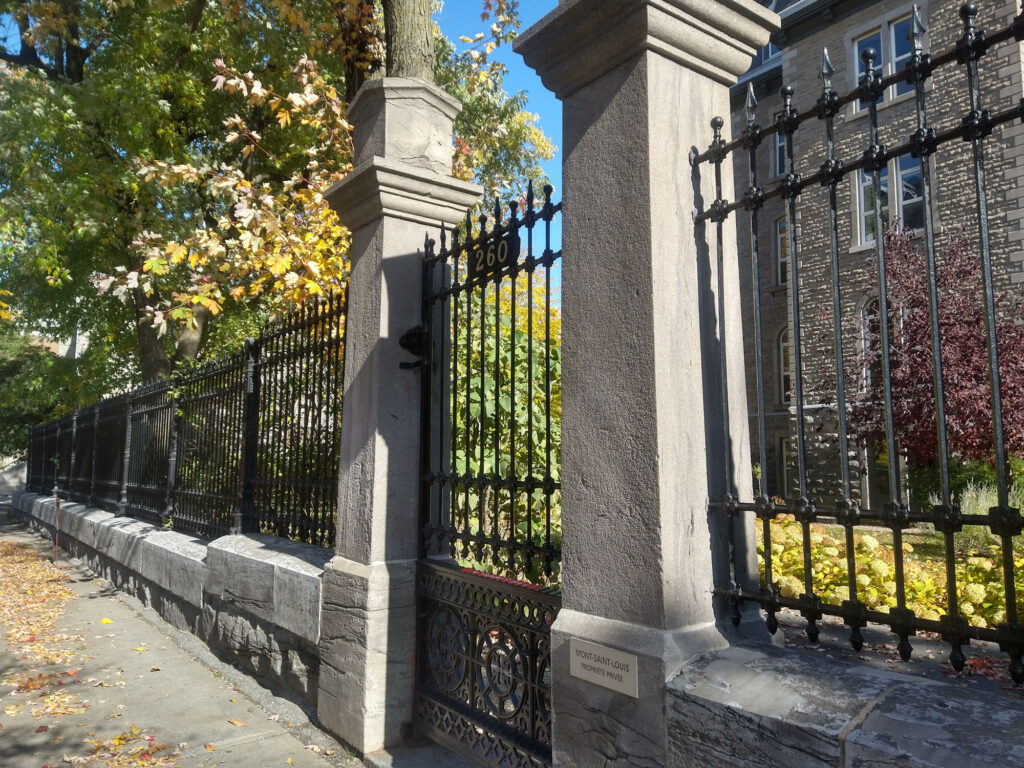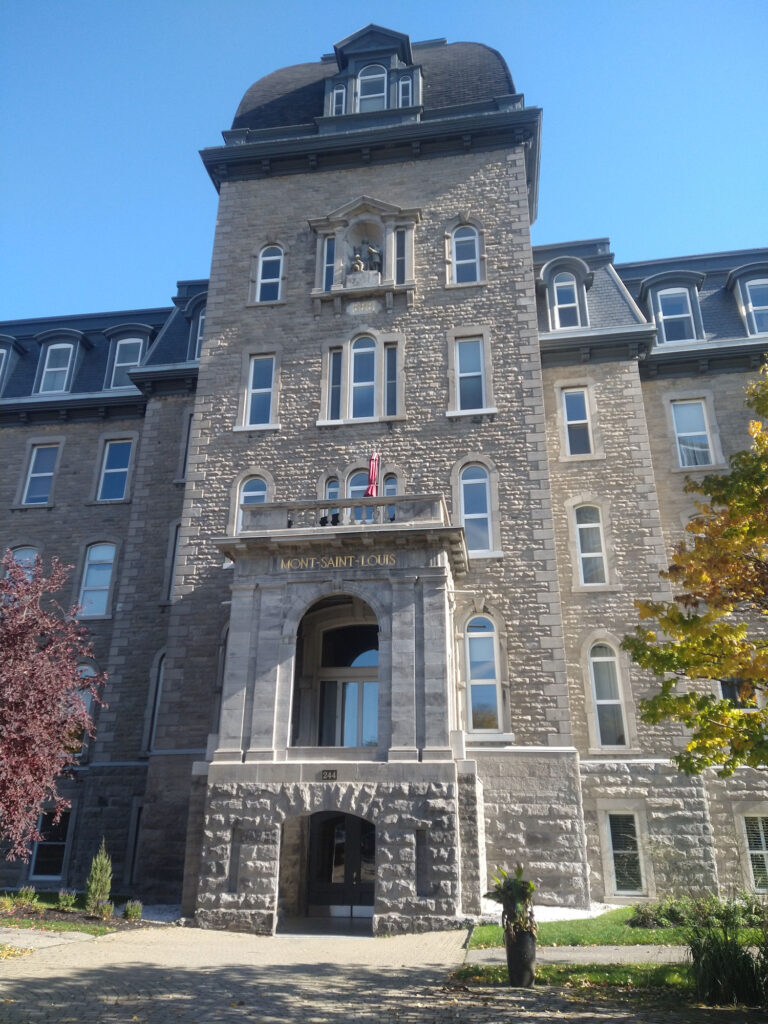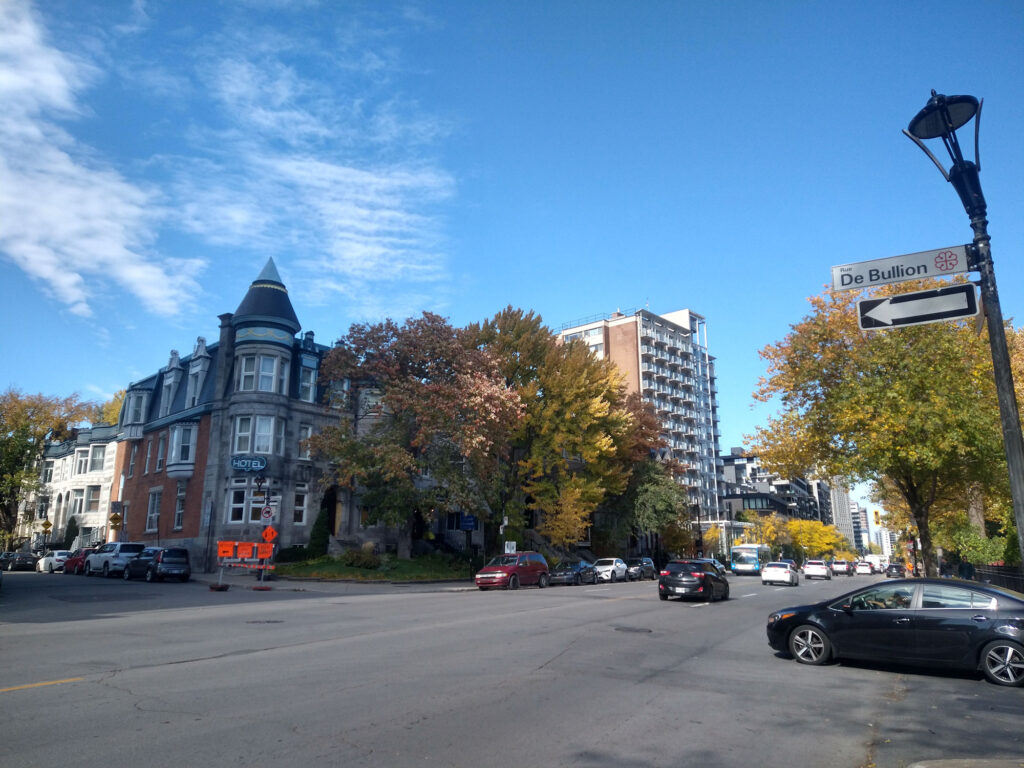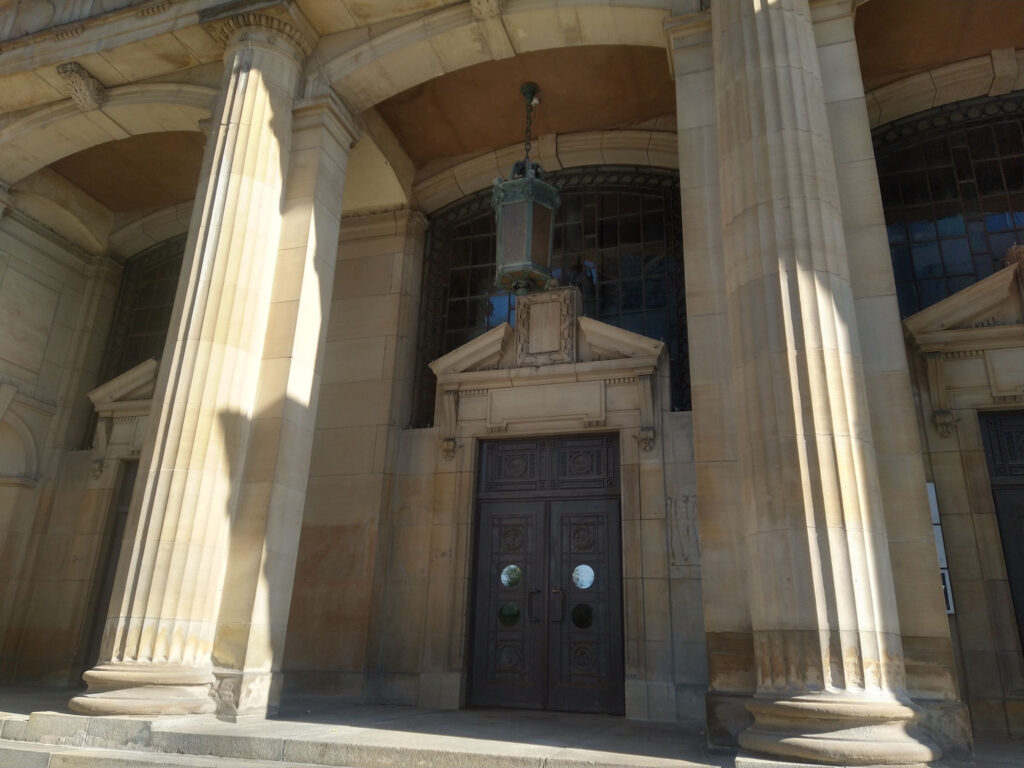WalkMontréal is pleased to bring you an exciting walk that will focus on neighbourhoods, urban renewal, architecture and heritage! This walk will start at Place des Arts and move eastwards on Sainte-Catherine Street, then north towards Beaudry Street and then back west along Sherbrooke Street. We will highlight the destruction of homes to build Place des Arts and how the skyline changed with Complexe Desjardins and Place Dupuis. We will see some beautiful Art Deco buildings (one was once the largest pharmacy in the world, the other being the Marché Saint-Jacques). And along the way we will walk thru The Village, seeing these streets as we make our way to Sherbrooke Street to explore the architecture there. There are also several micro-parks that we will highlight. So join C & D as they continue to walk the streets of Montréal.
Photos from this walk were taken on Saturday October 15, 2022, and Saturday October 22, 2022. (Header photo above is with credit to BANQ – Armour Landry, 1968).
Below map highlights the walk and points of interest. The walk is approximately 7.1 KM (4.4 MILES) and most of the terrain is flat, some incline on streets leading up to Sherbrooke Street.
We started this walk at the corner of Jeanne-Mance Street and President-Kennedy Avenue.
Corner of Jeanne-Mance Street and President-Kennedy Avenue.
If you look north on Jeanne-Mance Street, there are still some fabulous Victorian homes.
UQAM (L’Université du Québec à Montréal) has a big presence in this area of our walk.
Place des Arts as seen from President-Kennedy Avenue.
Salle Wilfrid Pelletier venue of Place des Arts.
Place des Art esplanade with Mount Royal in distance.
1949 map showing location where Place des Arts would eventually be built (direct centre). Families lived here on Winning Street and du Plateau Street.
Aerial view of area that was demolished in 1960. Winning and du Plateau streets are on center left. Bottom, facing Sainte-Catherine Street was the Institute and Chapel Dominique Savio, and top right was where the Academie Plateau stood. The bottom right corner was Woodhouse Furniture store which burned down in 1960. (credit Archives de la Ville de Montréal).
Preparing to build Place des Arts – 1960. On the left are row houses that were demolished to make way for Complexe Desjardins. (credit Archives de la Ville de Montréal).
Intersection of Winning and du Plateau streets, 1960 – now disappeared. (credit Archives de la Ville de Montréal).
Destruction of buildings on Winning Street and du Plateau Street, 1960. (credit Archives de la Ville de Montréal).
Destruction of buildings on Winning Street, 1960. (credit Archives de la Ville de Montréal).
Building of the Salle Wilfrid Pelletier venue of Place des Arts. (credit Archives de la Ville de Montréal).
Beautiful Mount Royal and it’s cross in the distance.
From the Place des Arts esplanade looking southwest.
From the Place des Arts esplanade looking west down Sainte-Catherine Street.
Complexe Desjardins, as seen from the Place des Arts esplanade.
Sainte-Catherine Street, runs between Place des Arts and Complexe Desjardins.
The Gazette, Friday December 7, 1973.
Complexe Desjardins main entrance.
Interior of Complexe Desjardins.
The Montreal Star, Saturday June 1, 1974.
Interior of Complexe Desjardins.
Let’s continue walking east on Sainte-Catherine Street.
Below is the Esplanade Tranquille, which gives honour to writer Henri Tranquille (Monsieur livre), and is the location of where his bookstore stood, Librairie Tranquille.
Librairie Tranquille (credit Université de Sherbrooke).
Clark Street, looking north.
Walk east on Sainte-Catherine Street…here is the intersection of Saint Laurent Boulevard (a.k.a Saint Lawrence Blvd; a.k.a. The Main).
If you’re hungry, you can make a slight deviation and walk south on The Main, the Montreal Pool Room has been serving hotdogs and fries since 1912.
The Main.
Église unie Saint-Jean, 110 Sainte-Catherine Street East, built between 1894-1896.
Église unie Saint-Jean, 110 Sainte-Catherine Street East, built between 1894-1896.
Corner of Sainte-Catherine Street East and Avenue Hôtel-de-Ville, where Henri Henri has been specializing in hats since 1932.
La Patrie Building, 110 Sainte-Catherine Street East, built in 1905 and once housed the offices and printing presses of the newspaper, La Patrie.
La Patrie Building, 110 Sainte-Catherine Street East, built in 1905 and once housed the offices and printing presses of the newspaper, La Patrie.
La Patrie Building, 110 Sainte-Catherine Street East, built in 1905 and once housed the offices and printing presses of the newspaper, La Patrie.
Continue walking east on Sainte-Catherine Street East.
Sainte-Catherine Street East.
Sainte-Catherine Street East at the intersection of Saint-Denis Street.
Notre-Dame-de-Lourdes Chapel, 430 Sainte-Catherine Street East, built between 1873-1876.
The dome of Notre-Dame-de-Lourdes Chapel.
Intersection of Sainte-Catherine Street East and Berri Street.
Intersection of Sainte-Catherine Street East and Berri Street.
Archambault Building, 500 Sainte-Catherine Street East, built in 1929 is another example of Art Deco in this city. Looking south on Berri Street.
Aerial view of the digging (direct centre) for construction of the Berri Metro Station in 1964 (credit Archives de la Ville de Montréal).
Main entrance for Berri-UQAM Metro station. This metro station is the busiest one in Montreal’s Metro system, connecting the orange, green, and yellow lines.
Looking north on Berri Street.
Intersection of Sainte-Catherine Street and St. Hubert Street. We come to Place Dupuis (origins from Dupuis Frères department store).
Place Dupuis, entrance at 1475 St. Hubert Street.
The Montreal Star, Saturday July 15, 1972,
Place Dupuis, entrance at 1475 St. Hubert Street.
Newspaper ad depicting Dupuis Frères and fashion in 1912 (credit BANQ).
Newspaper ad depicting Dupuis Frères and fashion in 1972 (credit Montreal Star – May 6, 1972).
Interior of Place Dupuis food court.
Place Dupuis on Sainte-Catherine Street, corner of Saint-Christophe Street.
Here is this street in 1961 (credit Archives de la Ville de Montréal).
And here is this street in early 1900’s (postcard).
We want to quickly walk north on St. Hubert Street and look back at Place Dupuis from De Maisonneuve Boulevard East.
At the corner of de Maisonneuve Boulevard and Berri Street, was the old Voyageur Bus Terminal.
At the corner of de Maisonneuve Boulevard and Berri Street, was the old Voyageur Bus Terminal.
We are going to walk north on Berri Street and take in the new inter-city bus terminal, Gare d’autocars de Montréal.
Gare d’autocars de Montréal.
Gare d’autocars de Montréal.
Gare d’autocars de Montréal.
Across the street is the Bibliothèque et Archives nationales du Québec (BAnQ).
Some street art opposite west side of Berri Street on Savoie Avenue.
Some street art opposite west side of Berri Street on Savoie Avenue.
Some street art opposite west side of Berri Street on Savoie Avenue.
Looking north on Berri Street.
Intersection of Berri Street and Ontario Street East.
Gare d’autocars de Montréal.
Looking north on Berri Street towards Sherbrooke Street East.
Hydro-Québec’s Berri Station.
We are going to turn around and go back south on Berri Street the way we came and make our way back to Sainte-Catherine Street East.
Now we are back on Sainte-Catherine Street East, let’s keep walking east.
This beautiful Art Deco building, at 916 Saint Catherine Street East and built in 1934, was once the largest pharmacy in the world.
Montreal Pharmacy in 1936 (credit Archives de la Ville de Montréal).
Interior of Pharmacie Montreal Pharmacy (postcard 1930’s).
The Montreal Daily Star – Friday November 30, 1934.
Exterior of Pharmacie Montreal Pharmacy (postcard 1930’s).
Former savings bank building, at 934 and 936 Sainte-Catherine Street East, built in 1904.
When you get to Saint-Timothée Street, walk south on this quaint street.
Some interesting details can be seen here.
The exterior wall of the Amherst Building (a.k.a. Théatre L’Olympia), built in 1925.
The exterior wall of the Amherst Building (a.k.a. Théatre L’Olympia), built in 1925.
Walk south on Saint-Timothée Street to René Lévesque Boulevard and turn up the next corner on Atateken Street. This is Parc Miville-Couture, named for Miville Couture a radio personality and satirist.
“Les Clochards Célestes”, by Pierre Yves Angers (created 1983).
Walking north on Atateken Street.
Once you reach Sainte-Catherine Street East, walk west one block back to Saint-Timothée Street and walk north on this street.
Intersection of Saint-Timothée Street and Robin Street.
Saint-Timothée Street looking north.
Saint-Timothée Street.
Saint-Timothée Street walking north.
Saint-Timothée Street walking north.
When you arrive at Ontario Street East, walk east one block and you will see the fabulous Art Deco Marché Saint-Jacques, built in 1931.
Marché Saint-Jacques, built in 1931. Beautiful Art Deco.
Marché Saint-Jacques, built in 1931. Beautiful Art Deco.
Marché Saint-Jacques, built in 1931, at 1125 Ontario Street East. Beautiful Art Deco.
The interior of Marché Saint-Jacques in 1943 (credit BANQ / La Presse archives).
Marché Saint-Jacques in 1930’s (credit Archives de la Ville de Montréal).
Marché Saint-Jacques, built in 1931. Beautiful Art Deco.
At the southwest corner of Ontario and Beaudry streets is the old fire station number 11, built in 1876.
We are now going to walk north on Beaudry Street.
Hommage to Paul Buissonneau, a leading francophone theatre director, who also was the director of La Roulotte, a travelling outdoor parks theatre.
And here is La Roulotte, with its travelling theatre in 1953 (credit Archives de la Ville de Montréal). We need this back!
Walking north on Beaudry Street.
Walking north on Beaudry Street.
Walking north on Beaudry Street.
Walking north on Beaudry Street.
Walking north on Beaudry Street.
Hommage to Quebec singer and actress Dominique Michel (Mural by HSIX).
Walking north on Beaudry Street.
When you get to Sherbrooke Street, walk west one block and then walk south on Montcalm Street,
Named after the Quebec journalist, we come to Parc Judith-Jasmin on Montcalm Street.
Parc Judith-Jasmin on the east side of Montcalm Street.
On the west side of Montcalm Street, we come to Parc Victor-T.-Daubigny, named after the veterinarian who founded École de Médecine Vétérinaire de Montréal.
Keep walking south on Montcalm Street, until you get to Ontario Street. On the southeast corner of this intersection is Parc Charles-Mayer, named after the sports journalist and city councillor.
Walk back west on Ontario Street for one block and turn north on Wolfe Street.
Walking north on Wolfe Street, there is also an entrance to Parc Victor-T.-Daubigny here as well.
Parc Victor-T.-Daubigny as seen from Wolfe Street.
Walking north on Wolfe Street.
Walking north on Wolfe Street.
Square-Amherst Street.
Square-Amherst Street.
Intersection of Square-Amherst Street and Atateken Street.
Walk south on Atateken Street.
Waling south on Atateken Street.
Marché Saint-Jacques is on east side of Atateken Street.
Marché Saint-Jacques is on east side of Atateken Street.
On the west side of Atateken Street is the old Bain Généreux, public bath built in 1926-1927, and is now a museum.
Bain Généreux, public bath built in 1926-1927, and is now a museum.
Bain Généreux, public bath built in 1926-1927, and is now a museum.
We have just completed a loop and are now back in front of the Marché Saint-Jacques.
Walk one block west to Saint-Timothée Street and walk north.
You will see the rear of the Bain Généreux here.
Walking north on Saint-Timothée Street, you will come to Parc Jean-Narrache. Émile Coderre was a pharmacist who used the pseudonym of Jean Narrache for his writings as a poet.
Walking north on Saint-Timothée Street, you will come to Parc Jean-Narrache. Émile Coderre was a pharmacist who used the pseudonym of Jean Narrache for his writings as a poet.
When you reach Sherbrooke Street, turn left and start walking west on Sherbrooke Street, admiring the beautiful architecture here.
More beautiful grey stone buildings.
Intersection of Sherbrooke Street East and Saint-André Street.
Continue west on Sherbrooke Street and you will arrive at Parc Simonne-Monet-Chartrand, named after the labour activist, feminist writer and pacifist.
Parc Simonne-Monet-Chartrand will lead you down some stairs to Saint-Christophe Street.
Parc Simonne-Monet-Chartrand will lead you down some stairs to Saint-Christophe Street.
Parc Simonne-Monet-Chartrand will lead you down some stairs to Saint-Christophe Street.
Parc Simonne-Monet-Chartrand will lead you down some stairs to Saint-Christophe Street.
Walk south on Saint-Christophe Street.
Walk south on Saint-Christophe Street.
Walk south on Saint-Christophe Street.
On the west side of Saint-Christophe Street, we come to Parc Claude-Mélançon, named after the naturalist and writer, Claude-Mélançon.
Parc Claude-Mélançon, named after the naturalist and writer, Claude-Mélançon.
Alley off of Saint-Christophe Street.
Looking back north on Saint-Christophe Street.
When you get to Ontario Street, walk one block west to Saint-Hubert Street. Intersection of Ontario Street and Saint-Hubert Street below.
Walk north on Saint-Hubert Street.
Walk north on Saint-Hubert Street.
Walking north on Saint-Hubert Street. Some beautiful homes here.
Walking north on Saint-Hubert Street.
Walking north on Saint-Hubert Street.
Walking north on Saint-Hubert Street.
Once you get to Sherbrooke Street, continue walking west. This the intersection of Berri Street and Sherbrooke Street, a contrast in architecture we just saw.
Let’s get back to some classic architecture…this is the Arthur Dubuc House, at 438 Sherbrooke Street East, built in 1894.
Arthur Dubuc House, at 438 Sherbrooke Street East, built in 1894.
Arthur Dubuc House, at 438 Sherbrooke Street East, built in 1894.
The François de Martigny house, at 430 Sherbrooke Street East, built in 1910.
Classic!
Another beautiful home at 426 Sherbrooke Street East, built in 1900.
Stone, mortar, cut stone and brick.
Looking back at these buildings.
Looking back at these buildings.
Sherbrooke Street East.
Intersection of Sherbrooke Street East and Saint-Denis Street.
Intersection of Sherbrooke Street East and Saint-Denis Street.
Continue walking east on Sherbrooke and take in the magnificent streetscape.
Continue walking east on Sherbrooke and take in the magnificent streetscape.
As you pass Sanguinet Street, you will come to the original Mont Saint-Louis religious school, at 244 Sherbrooke Street East, built between 1887-1888.
The original Mont Saint-Louis religious school, at 244 Sherbrooke Street East, built between 1887-1888. Now condominiums.
The original Mont Saint-Louis religious school, at 244 Sherbrooke Street East, built between 1887-1888. Now condominiums.
The original Mont Saint-Louis religious school, at 244 Sherbrooke Street East, built between 1887-1888. Now condominiums.
The original Mont Saint-Louis religious school, at 244 Sherbrooke Street East, built between 1887-1888. Now condominiums.
Peeking around the corner from L’Hôtel-de-Ville Avenue, corner Sherbrooke Street East.
Intersection of Sherbrooke Street East and L’Hôtel-de-Ville Avenue.
Alexander Buchanan House, at 170 Sherbrooke Street East, built in 1837.
Alexander Buchanan House, at 170 Sherbrooke Street East, built in 1837.
Alexander Buchanan House, at 170 Sherbrooke Street East, built in 1837.
Intersection of Sherbrooke Street East and De Bullion Street.
Intersection of Sherbrooke Street East and De Bullion Street.
Monastère du Bon-Pasteur, at 104 Sherbrooke Street East, built in 1846-1847.
Monastère du Bon-Pasteur, at 104 Sherbrooke Street East, built in 1846-1847.
Monastère du Bon-Pasteur, at 104 Sherbrooke Street East, built in 1846-1847.
Continue walking on Sherbrooke Street East and it becomes Sherbrooke Street West at Saint Laurent Boulevard. At 51 Sherbrooke Street West is the original residence of the photographer, William Notman
51 Sherbrooke Street West is the original residence of the photographer, William Notman
Continue on Sherbrooke Street West and take in the view of some more fabulous dwellings.
The Ludger-Duvernay House, at 82 Sherbrooke Street West, built in 1874.
Intersection of Sherbrooke Street West and Saint-Urbain Street.
Original École des Beaux-Arts, at 125 Sherbrooke Street West, built in 1905.
Original École des Beaux-Arts, at 125 Sherbrooke Street West, built in 1905.
Original École des Beaux-Arts, at 125 Sherbrooke Street West, built in 1905.
Continue walking west on Sherbrooke. This is the original École Technique de Montréal building at 200 Sherbrooke Street West, built in 1909-1911.
The original École Technique de Montréal building at 200 Sherbrooke Street West, built in 1909-1911.
Intersection of Sherbrooke Street West and Jeanne-Mance Street.
At 235 Sherbrooke Street West, you will find this apartment building that was built in 1965.
Continue walking west on Sherbrooke Street West. We are coming into skyscrapers now.
Still some Victorian row houses survive.
Approaching the intersection of Sherbrooke Street West and Bleury Street.
Southwest corner of the intersection of Sherbrooke and Bleury streets. The contrast of old and new.
This concludes our walk, we hope you enjoyed it and we always look forward to comments and suggestions. We wanted to highlight the ever-changing urban environment that we call a city and how neighbourhoods are affected or stay the same. Heritage is everywhere and the City of Montréal did a great job with the micro-parks we saw by naming them after distinguished persons and honouring them. The Art Deco buildings, a favourite of ours, is always great to see. But, walking the streets themselves is always a joy and learning experience. Keep in mind, WalkMontréal is an on-going effort by C & D to “Walk, Learn and Share”.




















































































































































































































WOWWWWWWW – Just incredible! I can’t believe I’ve lived in Montreal all my life and have never seen or cared to notice what you have shown and taught me in these beautiful pictures you have taken. Thank you for them and the trouble you have taken to provide all of the details on when they were built and who owned/built them. Outstanding work of love.
Thank you ! WalkMontreal is a joint effort by C & D to walk this beautiful city and learn and share. This is one of our favourites for sure. More coming in 2023!
Great walk and thank you! A great thing about living in Montreal is that walking is not only healthy, but always potentially a learning experience and a delight.
Thank you Robert. Happy you enjoyed the walk, Lots of history in this area.